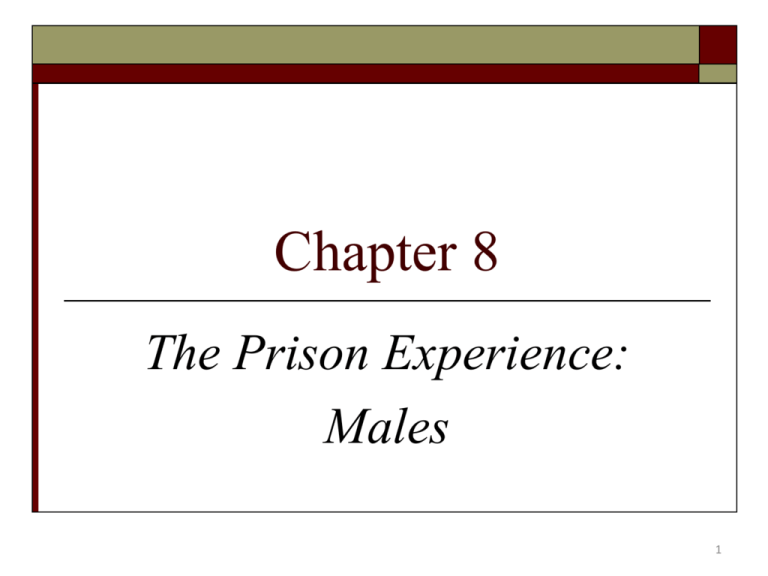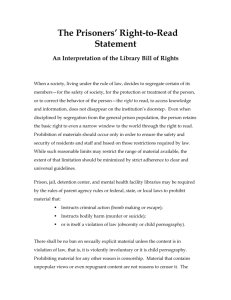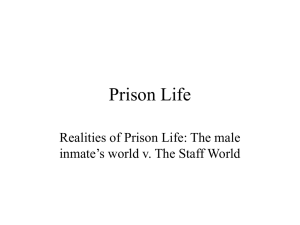
Chapter 8
The Prison Experience:
Males
1
Entering Prison
Total Institution – control over all aspects
No-frill policies
Initial orientation and Classification –
assessing risk and inmates needs
External classification: risk
Internal classification : housing and programs
Evaluation of classification
2
Entering Prison
Advantages of Classification:
Reduces institutional tension
Improves safety for staff and inmates
Avoids placing inmates in more secure and
expensive environment than they need
Contains gang activity
Improves access to services for inmates with
special needs
The Difficulties of Adjustment
Inmates go through a variety of attitude and
behavior changes
Initial treatment may seem harsh and inhuman
Learning to survive
Depression and coping skills
4
The Big House Era
Large fortress like prisons dominated corrections
in the early part of the twentieth century
Old “cons” informed new prisoners that the
guards were in control
Convicts developed their own social roles,
informal codes of behaviors, and language.
•
•
The inmate code of behavior dominated the inmate
culture
The process of learning and internalizing the code is
termed prisonization
5
The Big House Era
Sykes’ typology of inmate social roles:
Rats and center men
Gorillas and merchants
Wolves, punks, and fags
Real men
Toughs
Hipsters
Inmate Social Code
Don’t interfere with inmate interests
Never rat on a con
Do your own time
Don’t exploit fellow inmates
Be tough, be a man, never back down from a fight
Don’t trust the “hacks” or the things they stand for
Prisonization
The term, coined by Donald Clemmer, marks
the inmate giving up his or her identity and
became dependent on the system
Deprivation model
Importation model
Situational model
Administrative control model
Unique language or argot in prison
8
Contemporary Male Prison Culture
Near the end of the twentieth century, prison
culture took on new structure, language, and
mores
Prison Gang Structures
Also called security threat groups, they exist in at
least forty states and the federal system; often the
dominant force in inmate life
Origins in the 1960s and 1970s
Usually specialize in economic victimization
High levels of violence when gangs are in conflict
with one another
9
Contemporary Male Prison Culture
Changing racial patterns
By the 1990’s prisons were more racially
polarized than ever before
Today, much attention is being paid to the racial
integration of inmates
Prison contraband
Any unauthorized item possessed by an inmate
Introduction by visitors or staff
10
Sex in Prison
Typically occurs in three contexts
Consensual sex
Coercive sexual behavior
Sex for hire
The violence and brutality of inmates toward
other inmates is expressed in sexual
victimization
11
Sex in Prison
The Prison Rape Elimination Act of 2003
(PREA) established three new programs:
A program to collect national prison rape data
A program dedicated to the dissemination of
information and procedures for combating prison
rape
A program to assist in funding state programs
Expressions of Prison Violence
Riots and other major disturbances
The two most well known riots are Attica
(1971) and the riot at the New Mexico State
Penitentiary in Santa Fe (1980)
Riots require inmate solidarity
Riots can be spontaneous or planned
13
Expressions of Prison Violence
Inmate assaults on staff
Themes include:
Officer’s command
Protest
Search
Inmate’s fighting
Movement
Contraband
Expressions of Prison Violence
Inmates versus inmates
Staff assaults on inmates
Homemade weapons
Most violence occurs in high-security units
Self-inflicted violence: Prison suicide
The prison environment, marked by isolation and
deprivation leads to increased risk
Expressions of Prison Violence
What Causes Individual violence?
A history of prior violence
Psychological factors
Prison conditions
Lack of dispute-resolution mechanisms
Basic survival
Expressions of Prison Violence
What Causes Collective Violence?
Inmate-Balance Theory
Administrative-Control Theory
Overcrowding
Guarding the Prison
Correctional Officer Duties:
Housing Unit Officers
Work Detail Supervisors
Industrial Shop and School Officers
Yard Officers
Perimeter Security Officers
18
Guarding the Prison
Changing role of correctional officer
Conflicting goals and expectations
Female officer in male prisons
Officers’ response to problems on the job
Job enrichment: A challenge for
administrators






